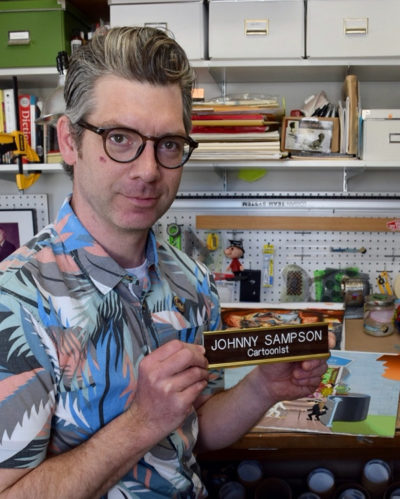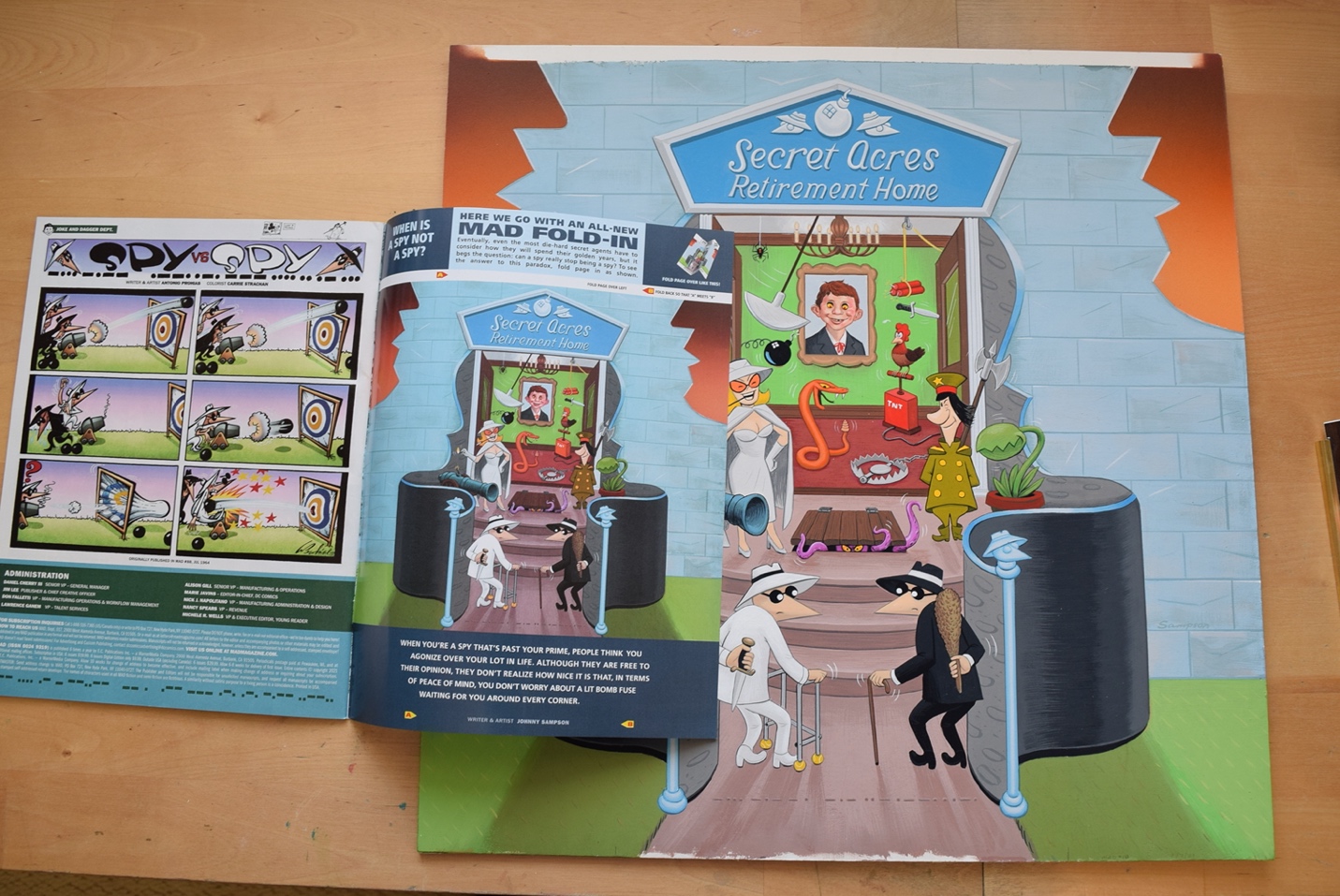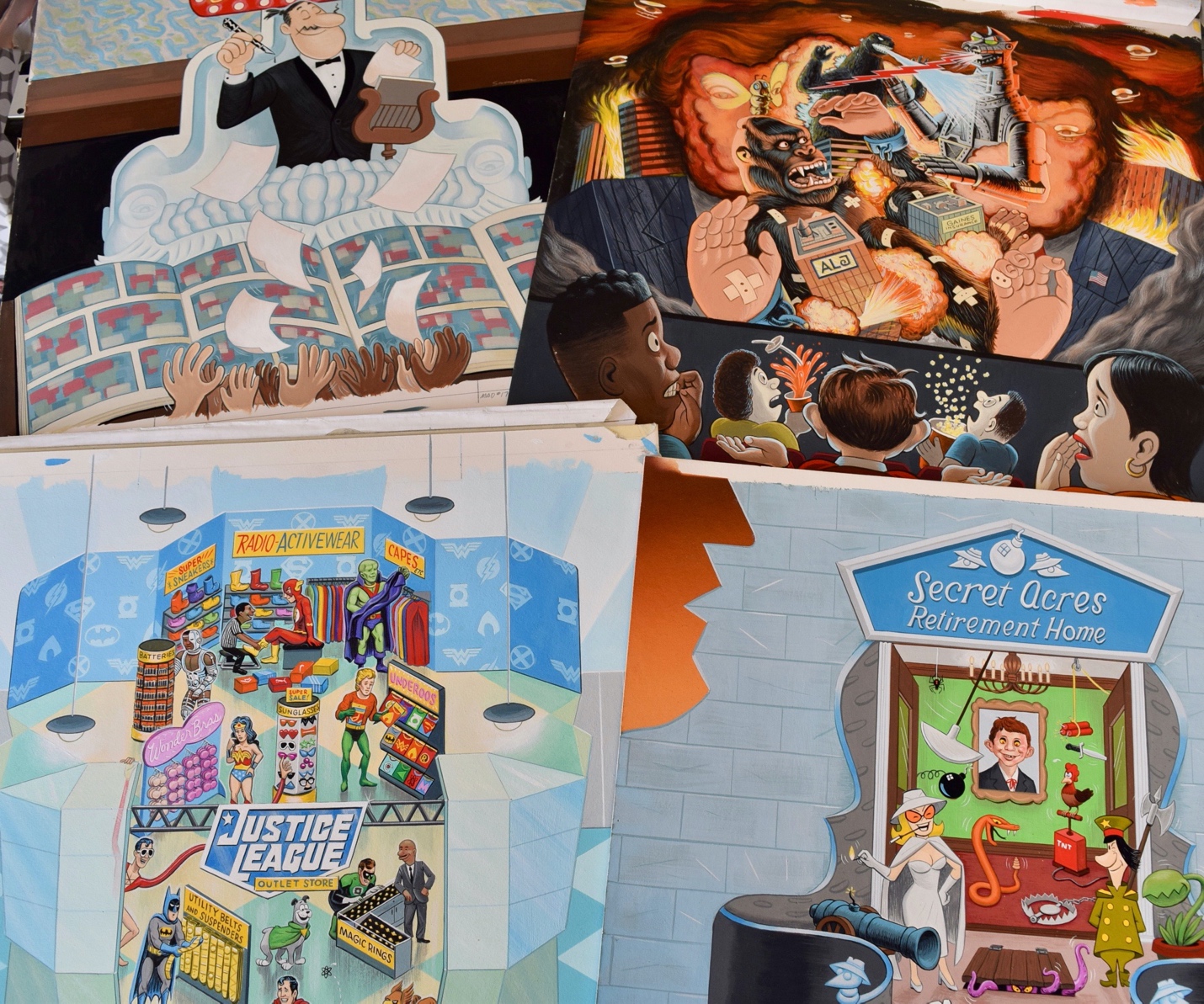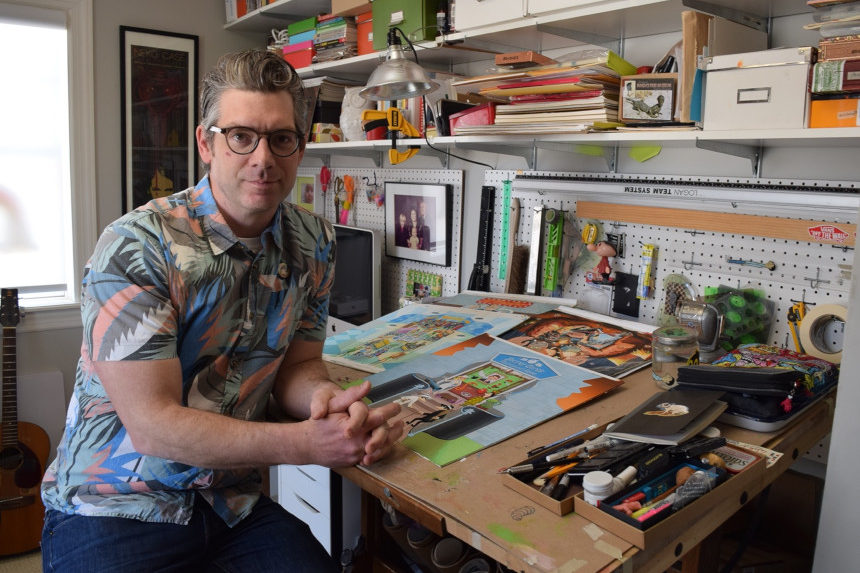Johnny Sampson got his current job at MAD magazine the old fashioned way — he sent a letter. It didn’t contain his resume or cover letter; it was actually more of fan letter to Al Jaffee, the father of the MAD original fold-in poster. In his letter, sent in 2013, he included his own fold-in that he created as a freelancer for Pitchfork’s magazine, The Pitchfork Review.
Sampson explains in his comic tru-ly MAD-ly that Jaffee, who turned 100 earlier this month, found the fold-in impressive and wrote back to Sampson saying that he “Couldna done it better himself.” Along with the praise, Jaffee offered to introduce Sampson to the MAD editorial staff as a way to line him up as his own successor. Sampson could not have anticipated the influence that this correspondence had on his career. “I didn’t think I would get anything out of it other than a nice note back,” Sampson says. “I wanted to get that little bit of validation.”
Today, Sampson is one of the only artists still producing new content for MAD. Budget constraints have forced the magazine to fill its latest publications with reprints from past magazines, making Sampson’s fold-ins that much more special. Although Sampson is one of the last cartoonists left at arguably the most famous cartoon publication in the country, he is a self-described “late bloomer” when it comes to comics.
Sampson says, “I just didn’t have an interest in superhero comics and part of that was because it seemed impenetrable, I didn’t even know where to start.” He always had an interest in comics — particularly Batman and alternative comics such as Peter Bagge’s Hate comics — but always thought that pursuing his passion professionally felt out of reach. “I didn’t have the know how or the wherewithal to even attempt doing something like that so it just felt like out of reach, like something that other people did” Sampson says. Instead of trying to wedge himself into the intimidating comics industry at an early age, Sampson went to college for painting.
At art school Sampson refined his craft and developed skills that would help him in the long run; however, it was not the most constructive environment for someone who had non-traditional artistic aspirations. “They would say that it’s too illustrative, too much like illustration. And they tried to discourage that because they felt that was a lesser endeavor, and that the real prize was fine arts.” Sampson says that school didn’t prepare him for what he wanted to do at all. “I kind of learned it down the road.”
Working on storyboards for a friend in college sparked Sampson’s interest in pursuing a career in storyboard design. After graduation he moved to Los Angeles to work on storyboards for film and television. While he was there, he continued to read the alternative comics he had always admired. Even though he was a successful illustrator in the storyboard community, he was still afraid to make the full leap to comics. Sampson says he was self-conscious about his writing. “I was more interested in creating an image and I still kind of had that art-think from college” Sampson says.
After leaving Hollywood, Sampson returned to Chicago in 2006 where he worked as fulltime freelance illustrator, producing gig posters for bands, covers for magazines, and more storyboards. In 2013, The Pitchfork Review contracted him to produce the fold-in that would spawn his career at MAD.

In order to prepare for the assignment, Sampson had only one person learn from — Jaffee himself. He used Jaffee’s MAD: Fold This Book! as a study guide for his creation.
Sampson began self-publishing in 2016 and that same year his comics starting appearing in MAD. While Sampson was included in Jaffee’s 100th birthday Zoom party this month, the legend and his successor do not correspond regularly. “I think he kind of gave me the keys to the car and I really haven’t gotten too much in the way of advice and techniques,” Sampson says. During non-pandemic times, whenever Sampson would travel to Comic Arts Brooklyn, a national comic book festival, he would stop by Jaffee’s studio to spend time with him and discuss their work. Sampson admits that he wishes that he could be in closer contact with Jaffee; however, he understands that the 100-year-old deserves some rest.
Although still relying on some of Jaffee’s techniques, Sampson has developed his own way of producing fold-ins. Like Jaffee, Sampson starts by sketching the solution to the fold-in and then “unfolding” the solution to draw the inside. After sending over his preliminary sketch to the MAD artistic director for approval, he deviates from Jaffee’s path by using Photoshop. The online program allows him to trace over his sketch to create a clean line drawing that he then prints out on a two large 11”x17” sheets of paper. He then uses carbon paper to transfer the drawing onto an illustration board.

Sampson says that this “is the make-or-break moment” of the process as once the image is on the illustration board, it cannot be folded. He has developed techniques to ensure that the fold-in will work correctly without actually folding the paper; it involves a complicated method of drawing faint lines where the folds will occur and using a thumbtack to sketch out the shapes the folds will create. To wrap up the poster, Sampson says, “I paint it in gouache which is an opaque watercolor” and then scans the final product and uploads it back to Photoshop. In Photoshop he can see if all of his hard work paid off.
Sampson usually does not time how long the entire process takes; however, he did keep track on his last production, and he admitted that it took him a whopping 37 hours. This week’s worth of work doesn’t even include the time it takes for him to brainstorm ideas, which usually takes place when Sampson is “just sitting down or watching TV.”

Although Sampson loves what he does, he understands that MAD will most likely not be around for much longer. “Honestly, I don’t know how much longer MAD can stick around. There is a lot of uncertainty around MAD and other print publications,” he says. This reality has instilled an unexpected sense of responsibility in Sampson. “I do feel a responsibility to satisfy the fans because they’re still subscribing and I’m the only new thing [in the magazine],” Sampson says. This responsibility has driven him to hone his craft even more.
Although the future of MAD is uncertain, Sampson is relishing every moment he has working for the magazine. One of the most rewarding aspects of his job as the fold-in master is how it keeps him on his toes. “Something that Al told me was that he really felt like it kept his mind fresh. It kept him sharp,” Sampson says. No matter how long the magazine lasts, Jaffee and Sampson’s connection and legacy will forever be immortalized in those one-of-a-kind, hilarious fold-in illustrations.
Featured image: Courtesy of Johnny Sampson
Become a Saturday Evening Post member and enjoy unlimited access. Subscribe now



